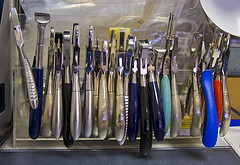It’s like a DIY solution for employers doing ergonomic assessments.

Photo: “tools of the trade” by liz west on flickr
The offering is STENA, and it’s created by Manu Nellutla and his team at the FIOSA-MIOSA Safety Alliance of BC. Manu is director of Research, Programs and Development – and he’s also an ergonomics specialist working with employers in manufacturing, food processing, and related industries.
STENA stands for “Specific Task Ergonomics Needs Assessment.”
This type of assessment uses a “systems approach” – and I asked Manu to elaborate on what that means.
“The importance of taking a systems approach to ergonomics is that the issues which lead to problems are usually much more complex than a simple change in the specific task, the specific machine, or the individual aspects of the work,” Manu explained, via email.
“Any change in one element can cause changes in other aspects of the overall task. For example, the ambient temperature – hot or cold – can impact the musculoskeletal system which could increase risk of injury.”
Meeting the demand
Many employers wanted assessments when the STENA program launched in 2013. The only way to meet this demand was to show employers how to do their own assessments. Thus the STENA+ program was created to put assessment tools in the hands of employers who could use them independently on their own premises.
“STENA+ offers training to the client on how to conduct ergonomics assessment themselves,” says Manu. “I go in and train an identified employee on fundamentals of ergonomics followed by actual assessment details. The participant is trained on how to use various ergonomics tools like WorkSafeBC’s Worksheet A and B, RULA, REBA, etc.”
“The training also includes discussion around writing a report with appropriate cost-effective recommendations. The report, as part of the training, is evaluated by the ergonomics advisor before. Aside from these, there are other ergonomics services including working on the design and process flow of a particular task in order to reduce repetitions, effort and time spent on a particular task.”
Looking at the work floor plan and processes is part of the observation process.
“Some of the most common problems of our clients that we have come across is not having a safety person who is able to identify, rectify or prevent musculoskeletal injuries,” Manu says. “What they also wanted was a simplified approach to understand how to conduct an ergonomics assessment.”
And they have one now – thanks to Manu and his team. Read Manu’s Ten Commandments of Ergonomics and get more info on STENA at the website of FIOSA-MIOSA – the health and safety association for manufacturers and food processors in B.C.


